Pig farming is an essential aspect of the global livestock industry, and it has become an increasingly profitable and sustainable business in recent years. This report focuses on the investment and profitability of pig farming, specifically focusing on producing 10, 20, 50, 100, and 500 pigs.
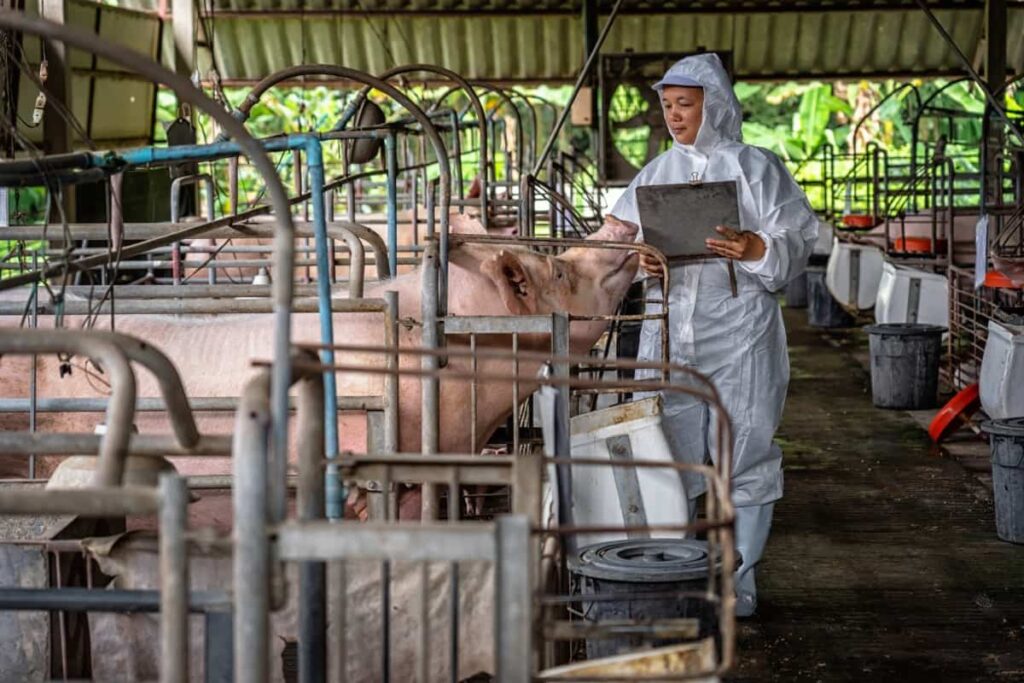
The report provides an overview of the initial capital required, production costs, and potential profits, as well as an analysis of the factors that impact profitability. Additionally, the report covers breeding and feeding requirements, housing and management practices, marketing and sales strategies, and other important aspects of successful pig farming.
Pig Farming Project Report
What is Pig Farming?
Pig farming is the breeding and raising domestic pigs for meat and skin production. Pigs are versatile animals that can be farmed in various ways, such as intensive commercial units, free-range commercial enterprises, or extensive farming. Commercial farms house thousands of pigs in climate-controlled buildings in developed nations, making intensive farming the most popular method due to its cost efficiency. Over one billion pigs are butchered worldwide yearly, with 100 million in the United States alone. Pigs provide meat but also skin, fat, and other materials for use in clothing, processed foods, cosmetics, and medical applications.
Factors Affecting Profit in Pig Farming
- Feed costs usually account for 60-70% of pig farming expenses.
- Proper nutrition and feeding practices can significantly impact pig growth rates, feed conversion ratios, and profitability.
- Disease outbreaks can cause losses ranging from 3-20% of the herd, so pig farmers need to prioritize biosecurity measures and develop a disease prevention plan.
- Genetics and breeding play a crucial role in pig farming profitability, with high-quality breeding stock leading to improved growth rates, litter sizes, and feed conversion ratios.
- Pork prices can fluctuate based on supply and demand, with prices often dropping during periods of oversupply, so pig farmers need to be aware of market conditions and adjust their production and marketing strategies accordingly.
- Pig housing design and management practices can impact pig health, productivity, and profitability, so proper housing design and management practices are important.
- Pig manure can be a valuable resource for pig farmers, as it can be used as fertilizer or sold as compost, leading to additional revenue streams and reduced waste.
In case you missed it: From Idea to Reality: A Comprehensive Project Report on Agro Shade Net Manufacturing in India
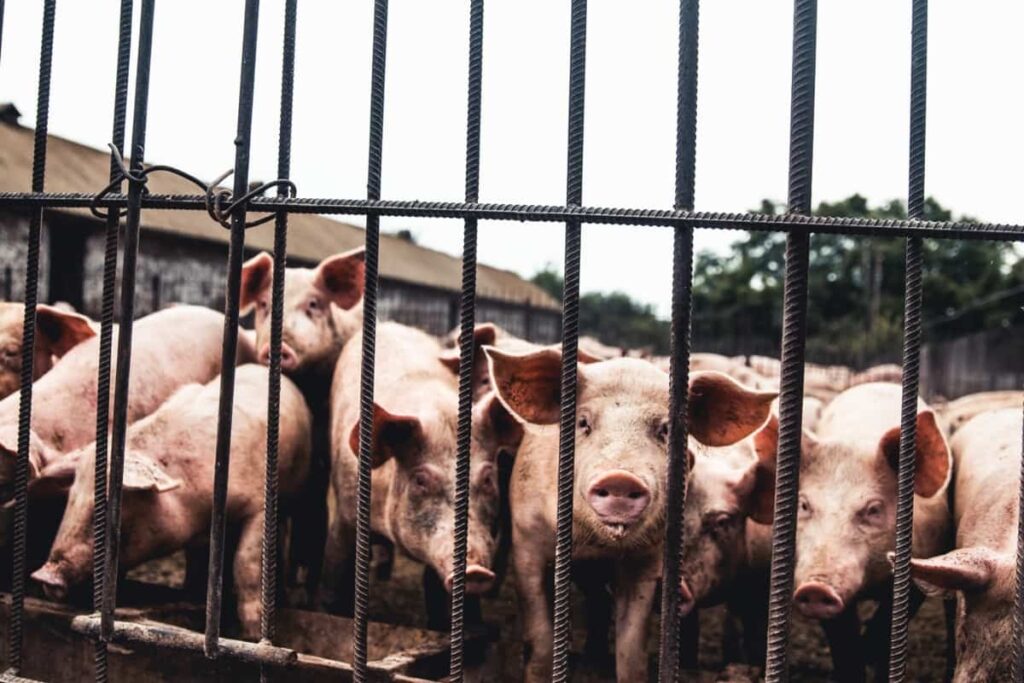
Importance and Benefits of Pig Farming in the Agricultural Sector
- Pigs have the highest feed conversion efficiency, producing more live weight gain from a given feed weight than other meat-producing animals except for broilers.
- They are also versatile in their diet, as they can consume various feed types and convert them into nutritious meat. Moreover, pig farming requires minimal investment in buildings and equipment.
- Pork is a nutritious meat with a high fat and low water content, rich in vitamins like thiamin, niacin, and riboflavin.
- Pig manure is a valuable fertilizer for agriculture farms and fish ponds. Pigs store fat quickly, making them in demand for various industries such as poultry feed, soap, paints, and chemicals.
- Pig farming is a lucrative enterprise, providing quick returns since the marketable weight of fatteners can be achieved within 6-8 months.
- Additionally, there is a high demand for pig products, including pork, in domestic and export markets.
Popular Pig Breeds for Commercial Pig Farming
Some of the most popular pig breeds for commercial pig farming include Landrace, Yorkshire, Duroc, Hampshire, and Berkshire. Landrace pigs are known for their high fertility rate and large litter, while Yorkshire pigs have excellent feed conversion rates and produce lean meat. Duroc pigs are known for their fast growth rates and good meat quality, while Hampshire pigs are known for their meat flavor and tenderness. Berkshire pigs have flavorful meat and are often preferred for high-end restaurants. Choosing a breed well-suited for the pig farming operation’s specific conditions and market demands is important to ensure the best profitability and success.
Pig Farming Project Report (Based on Success Story)
The project report is about setting up a pig-rearing farm for the Piggery. The project provides an opportunity for scientific pig rearing, generating revenue, and creating a sustainable livelihood opportunity for cooperative society members. The project report proposes rearing 200 (Hampshire Crossbred Pigs) in a hygienic shed for eight months until maturity and marketing the product to the market.
Objectives
- Increase the revenue of the Piggery unit.
- Provide gainful employment to members.
- Cater to the growing demand for pork in the region.
- Provide assured quality pork to consumers at a competitive price.
- Strengthen the rural membership of the Piggery unit.
In case you missed it: How to Start Pig Farming in Cambodia: Business Plan, Breeds, Cost, Profit, and Management
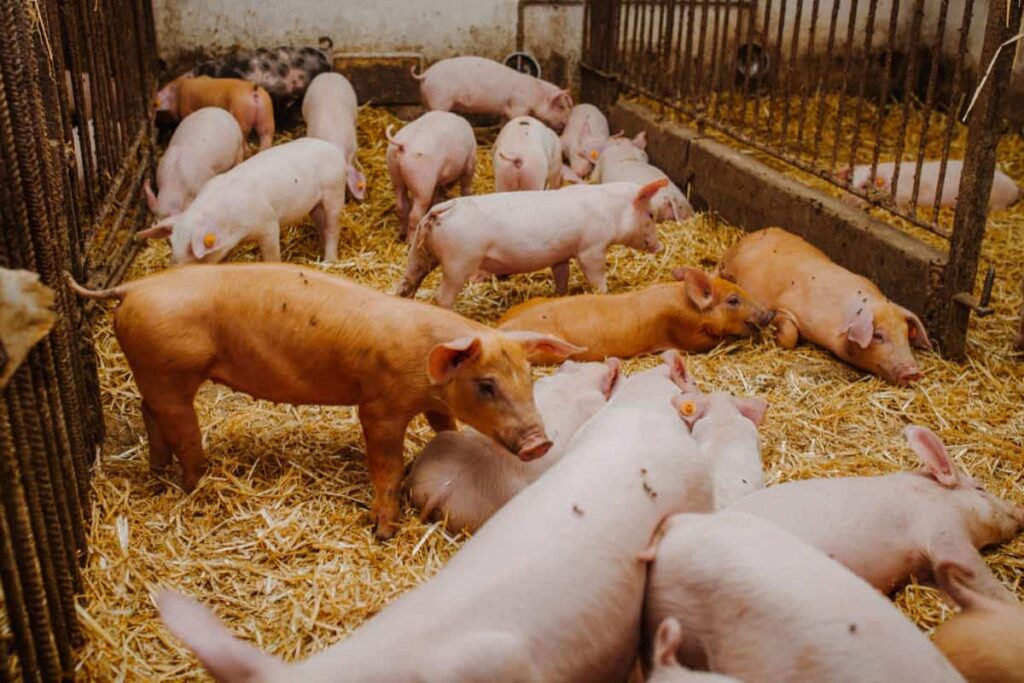
Project Proposal
The Piggery unit plans to procure 200 weaning piglets and nearby breeders in batches of 50 each at an interval of 15 days starting in May. The piglets will be scientifically reared in a hygienic shed with proper vaccination and feed for eight months until they reach maturity. The pigs will be marketed in the local market.
The first batch will be ready in the first half of December, and the last batch will be out by January last or February first half to cater to the peak demand in the festive season. The shed will be maintained in March and April for wear and tear, deep cleaning, and sterilization. The next batch will again start in May.
SWOT Analysis
Strengths
- High demand for pork in the region.
- Conducive Environmental and cultural factors for pig rearing.
- Ample forest produce and kitchen waste are available for pig feed.
- Tie-up with Pig Fed for the supply of piglets and feed.
- Ample availability of water and electricity.
- Good management body.
Weaknesses
- Less experience in large-scale pig rearing.
- High transportation cost due to difficult terrain.
- Less number of veterinary doctors are available.
- Increasing labor cost.
Opportunities
- Huge demand and supply gap for pork in the region
- High pork prices
- Easy availability of inputs required for pig farming
- Favorable climatic conditions for pig rearing
Threats
- The outbreak of diseases in the pig population
- High competition from other pig-rearing farms
- Fluctuating feed prices
- Natural disasters and climatic changes affecting pig rearing
Project Cost
The total project cost estimated is Rs.30 lakh, which does not include. Society and personal capital will contribute Rs.20 lakh of the project cost, and a financial institution will finance the balance.
Financial Viability
The project’s future cash flow has been worked out based on certain realistic assumptions. The Internal Rate of Return (IRR) worked out to be 21.66%, signifying that the project will be able to generate revenue in about 3.25 years to cover all the costs incurred in the project.
In case you missed it: How to Grow Pigeon Pea/Red Gram/Toor Dal: Cultivation Practices and Production Management
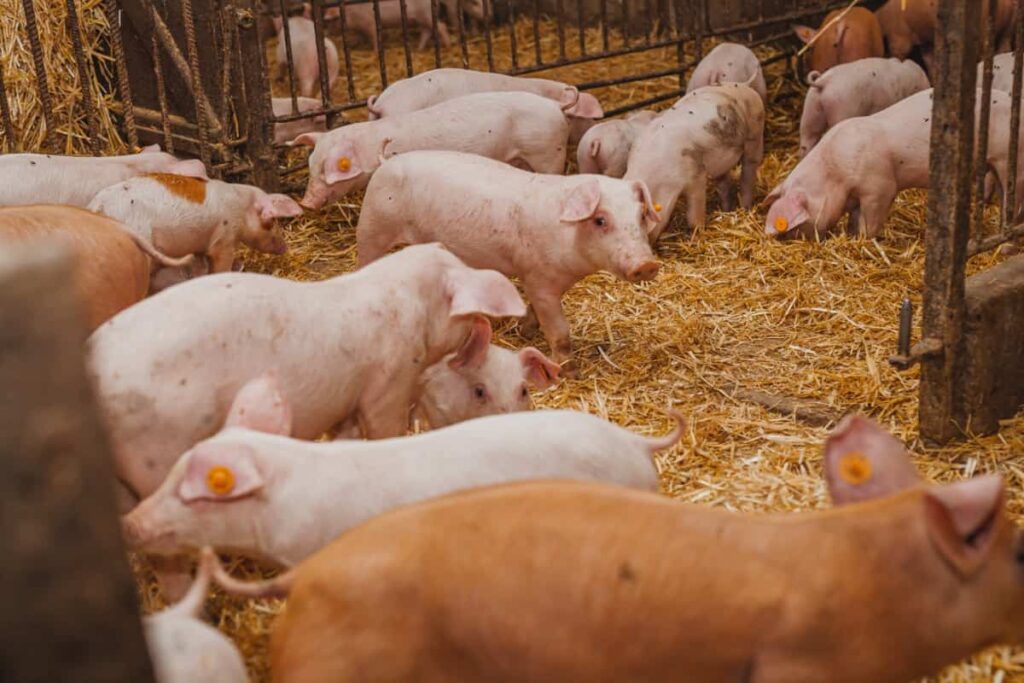
Conclusion
The project is technically feasible and financially viable. It will provide a good opportunity for pig rearing scientifically, generate revenue, and create a sustainable livelihood opportunity for cooperative society members. With favorable climatic conditions and ample availability of inputs required
Profit Projection for 10 Pigs (Investment and Profit)
Initial Investment
- Pig Farm Shade Cost: The cost of building a pig farm shade for ten pigs ranges between Rs 120,000 to 150,000 ($1,587.94 to $1,984.92), depending on the type of shade.
- Piglets: The cost of 10 piglets (9 female and 1 male) at Rs 3000 ($39.75) per piglet is Rs 30,000 ($397.51).
- Feed Cost: The cost of feed for ten pigs for 6-8 months is around Rs 2 lakh ($2,650.16).
- Biosecurity, Water, and Labor Cost: The cost of maintaining proper biosecurity measures, water supply, and labor for ten pigs is estimated to be Rs 35,000 ($463.77).
- Pig Farm Equipment Cost: Purchasing basic pig farming equipment, such as water troughs, feeders, and fencing, is estimated at Rs 15,000 ($198.75).
- Pig Medicine and Vaccination Cost: The cost of medicine and vaccination for ten pigs is estimated at Rs 9,000 ($119.25).
- Marketing and Transportation Cost: The cost of marketing and transporting the pigs to the market is estimated at Rs 10,000 ($132.50).
- Miscellaneous Cost: The miscellaneous cost includes expenses such as electricity and other expenses, estimated to be Rs 5,000 ($66.25).
Total Investment
The total investment for setting up a pig farming project for ten pigs is Rs 2,21,000 ($2,921.89).
Profit Projection
- Weight Gain: The weight of the 5-month-old pigs is between 117-127 kg (260-280 pounds). Assuming an average weight of 120 kg per pig, the total weight of 10 pigs is 1200 kg.
- Market Price of Pork: Pork prices vary between Rs 250-500 ($3.31-$6.62) per kg, depending on the region.
- Calculation of Revenue: Assuming a market price of Rs 350 ($4.63) per kg of pork, the total revenue from selling 1200 kg of pork is Rs 4,20,000 ($5,556.38).
- Calculation of Profit: The net Profit from the pig farming project can be calculated as follows:
- Total Revenue – Total Investment = Net Profit i.e. Rs 4,20,000 – Rs 2,21,000 = Rs 1,99,000 ($2,630.11)
Profit Projection for 20 Pigs (Investment and Profit )
Pig Farming Cost (20 Pigs)
| Pig farm shade cost | Pig shade price (20 pigs) Rs. 240,000 to 300,000 accordingly |
| One piglet price (baby pig) | Rs. 2,500 to Rs. 3,000 (33.12 USD to 39.75 USD) |
| 20 piglets cost | (19 female + 1 male pig) 20 piglets X Rs. 3,000 = Rs. 60,000 |
| Feed cost | Rs. 4 lakh |
| Biosecurity, water cost, and labor cost | Rs. 70,000 |
| Pig farm equipment cost | Rs. 30,000 |
| Pig medicine cost + Pig vaccination cost | Rs. 18,000 |
| Marketing and transportation | Rs. 20,000 |
| Miscellaneous | Rs. 10,000 |
| Total cost | Rs. 632,000 (8,377.25 USD) |
In case you missed it: How to Start Sustainable Pig Farming: Business Plan, Benefits, and Requirements
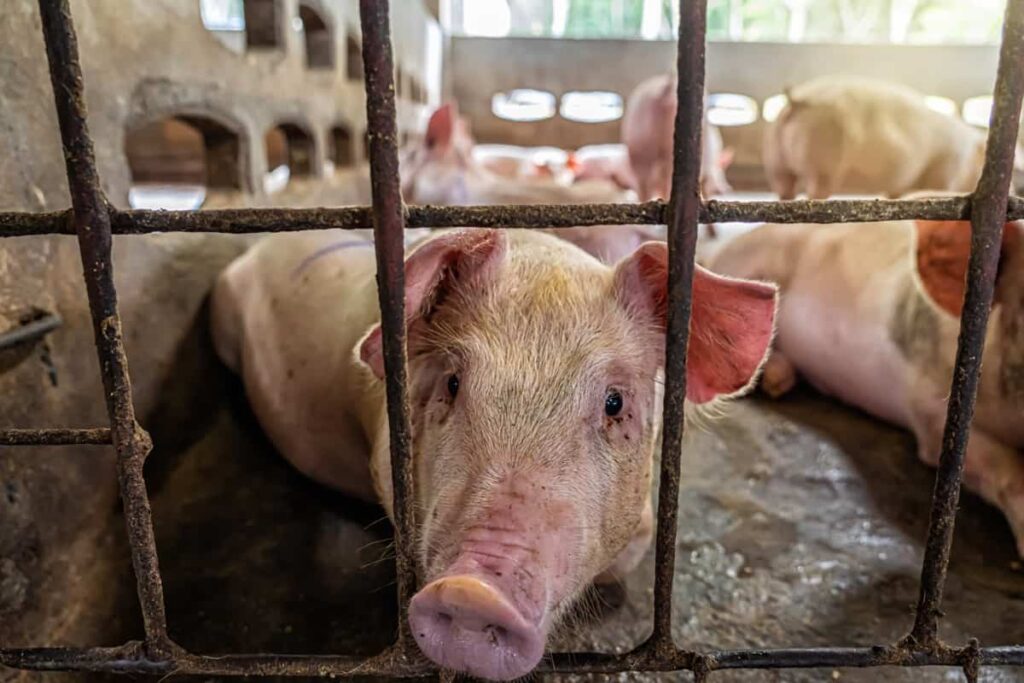
Pig Farming Profit Margin (20 Pigs)
- The average weight of boar = 200 kg (2 quintals)
- 1 kg pork price in India = Rs. 250 to Rs. 500 (according to region)
- If the weight of 1 pig is 180-200 kg, then: 20 pigs x 200 kg = 4000 kg
- The market price of 1 kg pork varies between Rs. 250 to Rs. 500
- Then, 4000 kg x Rs. 250 = Rs. 10,00,000 (13,269.58 USD)
- Net profit = Pig farming profit – Pig farming cost
- Net profit = Rs. 10,00,000 – Rs. 6,32,000
- Net profit = Rs. 3,68,000 (4,885.33 USD)
Profit Projection for 50 Pigs (Investment and Profit)
Pig Farming Cost (50 Pigs)
| Pig farm shade cost | Pig shade price (50 pigs) Rs 500,000 to 600,000 accordingly 50 |
| Piglet cost | (45 female + 5 male pigs) 50 piglet x Rs 3,000 = Rs 150,000 |
| Feed cost | Rs 10 lakh for Biosecurity and water Rs 175,000 for Labor |
| Pig farm equipment cost | Rs 50,000 |
| Pig medicine cost + Pig vaccination cost | Rs 25,000 |
| Marketing and transportation | Rs 20,000 |
| Miscellaneous | Rs 10,000 |
| Total cost | Rs 1,930,000 (25,607.67 USD) |
Pig Farming Profit Margin (50 Pigs)
- The average weight of boar = 200 kg (2 quintals)
- 1 kg pork price in India = Rs 240 to Rs 500
- If the weight of 1 pig is 180-200 kg, then
- 50 pigs x 200 kg = 10,000 kg
- The market price of 1 kg of pork varies between Rs 250 to Rs 500
- Then 10,000 kg x Rs 300 = Rs 3,000,000 (39,683.94 USD)
- Net profit = Pig farming profit minus pig farming cost
- Net profit = Rs 3,000,000 – Rs 1,930,000
- Net profit = Rs 1,070,000 (14,216.27 USD)
With an investment of Rs 1,930,000, a profit of Rs 1,070,000 can be expected from 50 pigs in a pig farming project. Note that actual profits may vary depending on market conditions and other factors.
Profit Projection for 100 Pigs (Investment and Profit)
Pig Farming Cost (100 Pigs)
| Pig farm shade cost | Rs 1,000,000 – 1,200,000 ($13,208.08 – $15,849.69) |
| Piglet price (100 piglets) | Rs 250,000 – 300,000 ($3,302.02 – $3,962.42) |
| Feed cost | Rs 2,000,000 ($26,416.16) |
| Biosecurity, water, and labor cost | Rs 500,000 ($6,604.04) |
| Pig farm equipment cost | Rs 150,000 ($1,981.21) |
| Pig medicine and vaccination cost | Rs 50,000 ($660.40) |
| Marketing and transportation cost | Rs 100,000 ($1,320.81) |
| Miscellaneous cost | Rs 50,000 ($660.40) |
| Total cost | Rs 4,100,000 – 4,500,000 ($54,039.22 – $59,376.12) |
In case you missed it: How to Make Silage for Livestock: Business Plan, Preparation Process for Goats, Sheep, Pigs, and Cows
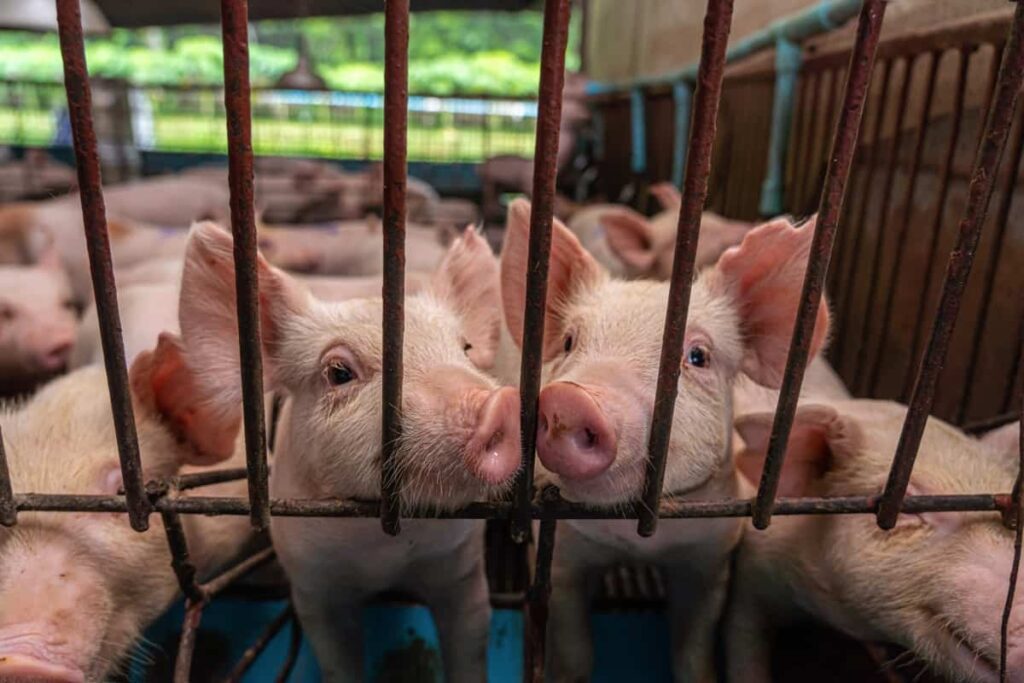
Pig Farming Profit Margin (100 Pigs)
- The average weight of boar: 200 kg
- pork price in India: Rs 250 – 500
- If the weight of 1 pig is 180-200 kg: 100 pigs x 200 kg = 20,000 kg
- The market price of 1 kg of pork varies between Rs 250 to Rs 500. Then, 20,000 kg x Rs 250 = Rs 5,000,000 ($66,040.40)
- Net profit = Pig Farming Profit – Pig Farming Cost
- Net profit = Rs 5,000,000 – Rs 4,100,000
- Net profit = Rs 900,000 – 1,400,000 ($11,881.21 – $18,456.32)
Therefore, the estimated net Profit for 100 pigs ranges from Rs 900,000 to 1,400,000 ($11,881.21 – $18,456.32). This projection is based on various factors such as market demand, cost of feed, and pork prices.
Profit Projection for 500 Pigs (Investment and Profit)
Pig Farming Cost (500 Pigs)
| Pig farm shade cost | Pig shade price (500 pigs) Rs 6,00,000 to 7,50,000 |
| 500 piglets cost | (450 female + 50 male pig) 500 piglets x Rs 3000 = Rs 15,00,000 |
| Feed cost | Rs 50,00,000 |
| Biosecurity, water cost, and labor cost | Rs 8,75,000 |
| Pig farm equipment cost | Rs 2,50,000 |
| Pig medicine cost + Pig vaccination cost | Rs 1,50,000 |
| Marketing and transportation | Rs 50,000 |
| Miscellaneous cost | Rs 1,00,000 |
| Total cost | Rs 84,75,000 ($1,126,000) |
Pig Farming Profit Margin (500 Pigs)
- The average weight of boar = 200 kg (2 quintals)
- 1 kg pork in India = Rs 250 to Rs 550 (according to region)
- If the weight of 1 pig is 180-200 kg, then 500 pigs x 200 kg = 100000 kg
- The market price of 1 kg of pork varies between Rs 250 to Rs 500
- Then 100000 kg x Rs 250 = Rs 2,50,00,000 (3,327,375 USD)
- Net profit = Pig farming profit – Pig farming cost
- Net profit = Rs 2,50,00,000 – Rs 84,75,000
- Net profit = Rs 1,65,25,000 (2,198,640 USD)
The expected Profit from 500 pigs is approximately Rs 1-1.5 crore ($133,000-$200,000). The actual Profit can vary based on market demand, feed prices, and management practices.
Conclusion
Pig farming can be a profitable venture with a relatively low investment. The profit margin increases with the number of pigs. For ten pigs, the Profit can be around 1 lakh. As the number of pigs increases, so makes the Profit, with a projection of up to 1.5 crores for 500 pigs. Choosing the right breed, proper management, and marketing strategies can enhance profitability.
- How to Raise Pigs in Your Own Backyard: A Comprehensive Guide
- Budget Friendly Sheep Shed Ideas: Cheap and Low-Cost Tips
- How Much Do Cattle Farmers Make: Revenue Streams in Cattle Farming
- Management Pests and Diseases in Your Cotton Field
- Sheep Farming Business Plan for Beginners
- Aquaponic Farming at Home: A Step-By-Step Guide
- Profitable Village Farming Business Ideas in 2024
- High-Yield Aquaculture: Fast-Growing Fish for Farming
- Effective Fish Pond Construction Techniques for Beginners
- Irrigation and Water Management in Pineapple Farming
- Blossom to Harvest: Mastering Flowering and Pollination in Papaya Farming
- Pig Fattening Essentials: From Selection to Sale for Beginners
- Raising Wagyu Cattle: A Complete Guide for Premium Beef Production
- Soil Types and Their Water Holding Capacity
- Optimizing Irrigation Schedules for Coconut Groves for Enhanced Yield
- Espresso Your Garden: Coffee Grounds for Healthier Acid-Loving Plants
- The Best Soil Mix for Snake Plants: How to Mix Your Own Snake Plant Soil
- Green Thumb Success: Expert Tips for Cultivating Greenhouse Beans All Year Round
- Bloom All Year Round: The Ultimate Guide to Indoor Hyacinth Care
- Eco-Friendly Gardening: How to Make Liquid Fertilizer from Kitchen Waste
- Ultimate Guide to Grow Anise in Pots: Explore Seed Propagation to Harvesting
- Guide to Raising Chester White Pigs: Discover Breed Facts to Growth Management
- Mastering the Elegance: The Ultimate Guide to Weeping Cherry Tree Care, Planting, and Maintenance
- Ultimate Guide to Planting Garlic in Grow Bags: Growing Strategies for Beginners
- How to Fix Spider Plant Leaf-Related Problems: Natural and Organic Remedies
- 10 Reasons Why Your Tulsi Plant is Shedding Leaves: Home Remedies and Solutions
- Optimizing Growth and Yield: The Advantages of Palm Bunch Ash Fertilizer
- Utilizing Neem Oil Extract as a Natural Pesticide for Hydrangea
- From Soil to Harvest: Various Ways in Which Farmers Can Use AI Tools
- Steps to Encourage and Induce Citrus Flowers: A Comprehensive Guide
- How to Fix Snake Plant Leaf-Related Issues: Natural and Organic Remedies
- Transform Your Garden into a Fragrant Oasis with Raat Ki Rani (Night Blooming Jasmine)
- Discover the Ideal Chicken Breeds for Philippine Farms
- How to Create a Poultry Egg Farm Business Plan for Profits
- Grow Lemon Cucumbers Like a Pro: Insider Techniques for Bountiful Yields
- Ultimate Guide to Caring for Your Pink Princess Philodendron: Tips for Thriving Variegation
